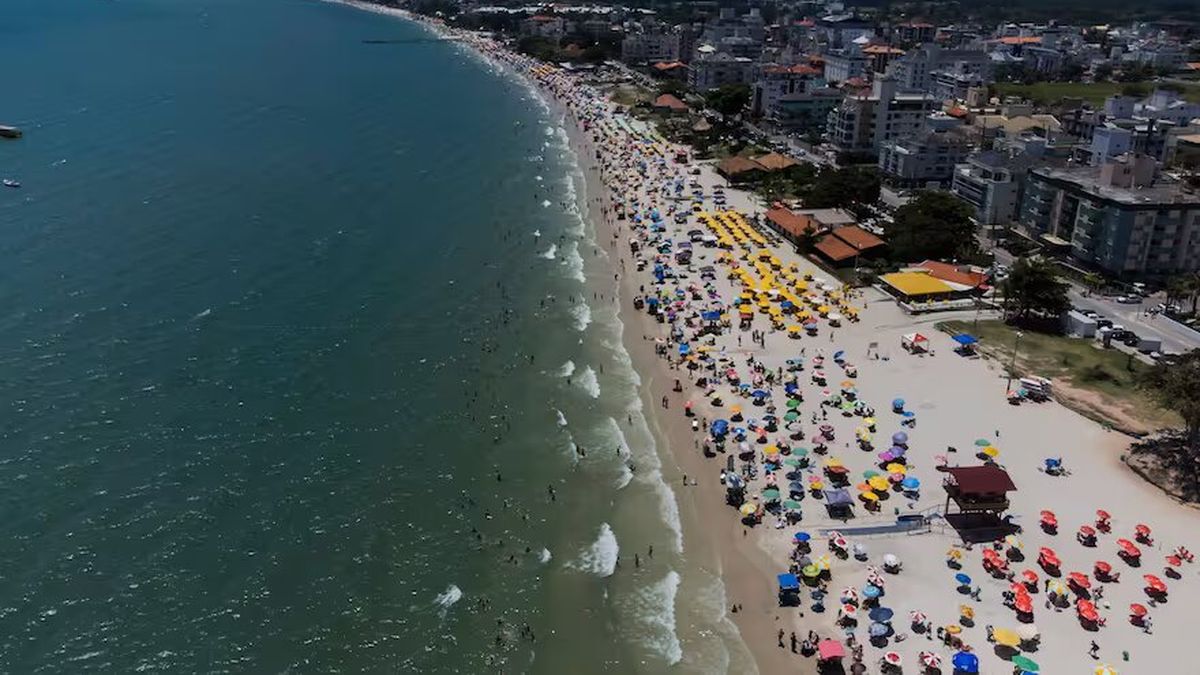Hundreds of thousands of Argentines chose Brazil as their seasonal destination this summer season and, within the neighboring country, Florianópolis is one of the most visited sites. However, an unexpected setback occurred for tourists visiting the beaches: An outbreak of viral diarrhea affects more than 50% of the coast of the coastal town.
In detail, the affected beaches were declared unsuitable for bathing due to water contamination, and the problem affects different popular destinations, such as Canasvieiras, I will swear, Bombinhas and Camboriú Spa. Among the most common symptoms of viral gastroenteritis are: watery diarrhea, abdominal pain or cramps, nausea or vomiting, and fever. That is why the Brazilian authorities issued a Balneability Map to know which waters are safe and seek to promote other types of activities in the City for tourists who traveled to enjoy the summer.
What is viral diarrhea that affects Florianópolis
The problem of the condition is attributed to collapse of sewage systems and the dumping of untreated wastea situation that was aggravated by the increase in visitors and unfavorable weather conditions. Local authorities, together with the Institute of Environment of Santa Catarina (IMA), implemented strict controls and regularly update a Balneability Map to inform the population about safe beaches and those with health risks.
In this scenario, specialists warned about the need to redouble care, especially at this time of year, characterized by high temperatures and tourist activity.
This disease is a symptom of viral gastroenteritisan intestinal infection caused by viruses that is characterized by inflammation of the stomach and intestines. In addition, those infected may also present other symptoms such as: watery diarrhea, abdominal pain or cramps, nausea or vomiting, and fever.
Viral gastroenteritis is spread by contact with an infected person or by consuming contaminated food or water. It is the most common form of gastroenteritis and diarrhea worldwide. Viral gastroenteritis usually lasts between one and three days, but can last up to ten.
How to prevent viral diarrhea
Because there are no vaccines Against this stomach infection, health experts recommend following the following measures to prevent contagion:
- Wash your hands frequently.
- Avoid water and food that may be contaminated.
- Wash fruits and vegetables.
- Cook seafood completely.
- Avoid preparing meals for others if you are sick and for up to two days after symptoms disappear.
- Constantly disinfect surfaces that may be contaminated.
- Be careful when traveling if you travel to areas with many infections and keep spaces ventilated.
- Avoid close contact with people who may be infected.
What to do in Florianópolis
Beach vacations have only one setback: rainy and cloudy days. Florianópolis, the capital of the Brazilian state of Santa Catarina, with its more than 40 beaches and splendid nature, offers a wide variety of alternative plans when the weather is not favorable. This season, the problems arising from the outbreak of viral diarrhea in the area were also added.
florianopolis.jpg
In a record season, hundreds of thousands of Argentines chose Brazil as their summer destination.
According to the local Tourist Office, Nearly 210,000 Argentines visited the capital of Santa Catarina last year. More than half of them traveled by plane, an estimated 130,000 people according to local authorities. By plane, Florianópolis airport (Hercílio Luz) is the most popular arrival destination from Argentina, located in the south of the island and 18 km from the center of the capital. Let’s review the walking alternatives when the weather is not good:
- Public Market: Located in the center of the city, it is a multipurpose destination: you can eat, have a drink, buy seafood, look at local crafts, browse the shops and get information at the Tourist Service Center. The Market has a long history: already in the 17th century, merchants set up stalls to sell all kinds of products on the beach, in front of the current Plaza XV de Novembro. The Public Market was inaugurated in January 1851 and was located on the seafront, but in the 1970s, direct access to the beach was blocked, and a few years later, the building was declared a municipal heritage site. In 2005, a fire broke out and the building had to be recycled and reopened in 2015. The stores have different hours and it is worth checking on the Floripa Public Market website. Address: Rua Jeronimo Coelho, 60, Centro.
- Historical Museum of Santa Catarina: pThat is, furniture, paintings, sculptures, printed documents, medals, photographs and weapons from the 19th and 20th centuries. It also has an interesting archaeological collection, with objects found during an excavation in the palace. Located in the Cruz e Souza Palace, the current museum was built as the Government House in the 18th century. In 1977, important restoration works began on the building, which was renamed Palacio Cruz e Sousa in 1979, in honor of the poet from Santa Catarina. In 1984, the building was declared a state heritage site and new restoration works began until its reopening in 1986. Admission is free (closed on Sundays and holidays). Address: Praça XV de Novembro, 227, Centro.
- Casa da Alfandega: Customs houses the Galería do Artesanato project, where visitors can find crafts with typical Florianópolis motifs, such as the papaya ox, witches, beaches, the Hercílio Luz bridge and fishermen. It is a good place to buy souvenirs of the city. The building was inaugurated on July 29, 1876, according to the Fundação Catarinense de Cultura (FCC), which manages the space, and began operating the following year. At that time, it housed the Customs House, which lasted for 90 years and ended after the closure of the port of Florianópolis. Open Monday to Friday from 9:00 a.m. to 6:00 p.m. and Saturdays from 9:00 a.m. to 1:00 p.m., with free entry. Address: Rua Conselheiro Mafra, 168, Centro.
- Integrated Culture Center (CIC): houses exhibition halls, sector libraries, cinema, the Ademir Rosa Theater, the Santa Catarina Art Museum, the Museum of Image and Sound, the Art Workshops, the Art School, the Conservation Workshop and Restoration of Movable Cultural Assets and the administration of the Santa Catarina Foundation for Culture. The Santa Catarina Art Museum (MASC) usually houses samples of paintings and sculptures. The Museum of Image and Sound (MIS) has films, music on vinyl, CDs and cassettes, photographs and equipment. The schedule is from 10:00 a.m. to 8:00 p.m., admission is free and the program can be consulted on the website of the Fundação Catarinense de Cultura (FCC). Address: Avenida Governador Irineu Bornhausen, Agronômica.
- Florianópolis Museum: Inaugurated in 2021, the Florianópolis Museum is located in the former headquarters of the Municipal Government and Jail, in the center of the city, which is the reason for its exhibitions. This museum is about the capital of Santa Catarina itself and pays tribute to its history and its rich natural environment. In addition to long-term exhibitions, there are also temporary exhibitions. Admission costs 10 reais per person and the museum is closed on Mondays. Address: 242, R. dos Ilhéus, 194 – Centro.
- Fortress of São José da Ponta Grossa: It is located on Praia do Forte and was built in the 18th century. Together with the fortresses of Santa Cruz de Anhatomirim and Santo Antônio de Ratones, it completed the triangular defense system that was to protect the northern part of the island from foreign attacks and consolidate the Portuguese occupation in southern Brazil. In 1938, already in ruins, it was cataloged by the National Historical and Artistic Heritage Service, currently IPHAN, and in the 1970s and 1980s, archaeological surveys and partial restoration work were carried out, which culminated in 1992. January In March, it opens from 9 a.m. to 12 p.m. and from 1 p.m. to 6 p.m., with a price of 16 reais. Children and those over 60 years of age do not pay.
- Armazém Rita Maria: A place where gastronomy and entertainment combine is the Armazém Rita Maria, a complex of recycled port warehouses erected in 1895 that includes shops, restaurants, bars, ice cream parlors and art galleries, and the Top Market Floripa, a top gastronomic hub. eclectic. Address: Alameda Annita Hoepcke da Silva, 112, Centro (parking access).
How many beaches in Florianópolis are optimal for bathing?
He Balneability Map It is a tool developed by the IMA that indicates the quality of the water on the beaches of Santa Catarina. This map classifies coastal areas using a flag system:
- Red flags: Beaches not suitable for bathing due to high levels of contamination by bacteria, viruses or other pathogens.
- Blue flags: Beaches considered safe and suitable for recreational activities.
- Black flags: Beaches that were not studied or their research was not conclusive about the risks posed by bathing in such waters.
image.png

The classification of beaches according to their safety for bathing in Florianópolis.
Santa Catarina Environment Institute.
This tool is available online through the official site of the Santa Catarina Environment Institute. There, the conditions of each beach are updated in real time, allowing you to verify which ones are safe and which ones should be avoided.
The monitoring carried out by the authorities includes laboratory tests that detect the presence of microorganisms such as Escherichia coliresponsible for gastrointestinal diseases. This allows tourists and residents to make informed decisions and prevent health risks.
The latest report issued by the Environmental Institute of Santa Catarina (IMA) indicates that in the week of December 30, 2024 to January 3, 2025, a little more than 60% of the beaches in the State They are in optimal condition.
“According to the 238 points monitored by the Institute on the Santa Catarina coast, 151 are suitable for bathing, which represents 63.45%. In Florianópolis, of the 87 points, 56 are suitable for bathing, which is equivalent to 64.37%”, highlights the report that is updated every Friday.
Steps to consult the map:
- Enter the official IMA website.
- Select the “Beachability” or “Beach Map” section.
- Search for the beach of interest in the list or the interactive map.
- Consult the color of the assigned flag to evaluate the risk.
This resource is essential to protect the health of tourists and prevent the spread of diseases in affected areas.
Source: Ambito
I am a 24-year-old writer and journalist who has been working in the news industry for the past two years. I write primarily about market news, so if you’re looking for insights into what’s going on in the stock market or economic indicators, you’ve come to the right place. I also dabble in writing articles on lifestyle trends and pop culture news.




